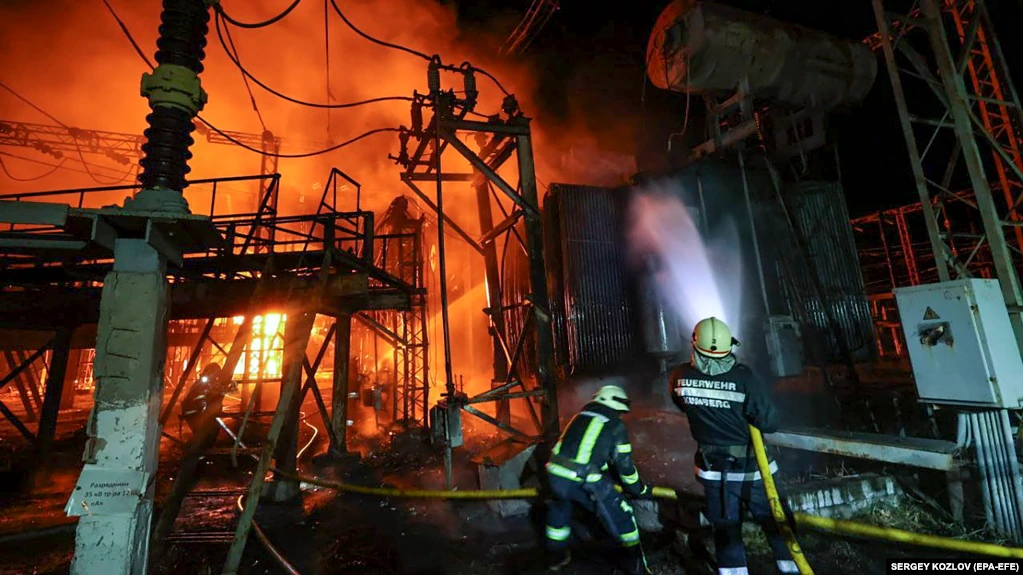KYIV — Ukrainian officials said “vile” Russian missile strikes on civilian energy sites have caused power outages nationwide, leaving more than a million households without electricity, while Russian authorities ordered residents to leave Kherson “immediately” ahead of an expected effort by Kyiv’s forces to retake the crucial southern city.
Ukrainian President Volodymyr Zelenskiy said on Telegram on October 22 that Russia carried out a “massive attack” on Ukraine overnight and that “the aggressor continues to terrorize our country.”
“At night, the enemy launched a massive attack: 36 rockets, most of which were shot down…These are vile strikes on critical objects. Typical tactics of terrorists,” he wrote. “The world can and must stop this terror.”
Kyrylo Tymoshenko, deputy head of Zelenskiy’s office, said Ukrainian air defense forces had shot down 18 of the missiles.
Kyiv Mayor Vitali Klitschko said a number of missiles had been shot down on the approach to the capital.
“Several rockets flying toward Kyiv were shot down in the region by air defense forces. Thanks to our defenders!” Klitschko said.
There was no immediate word on deaths related to the missile attacks, but officials said several people had been injured.
It was not possible to verify the reports on either side.
In the face of continued Russian strikes, Foreign Minister Dmitro Kuleba again urged Ukraine’s Western allies to speed up the delivery of modern air defense systems.
“We intercepted some, others hit the targets. Air defense saves lives. In [Western] capitals, there should not be a single minute of delay in the decision regarding air defense systems for Ukraine,” Kuleba said.
Local officials said power stations were hit in the regions of Odesa, Kirovohrad, and Lutsk, while other regions reported problems with electricity.
“Another rocket attack from terrorists who are fighting against civilian infrastructure and people,” the Ukrainian president’s chief of staff, Andriy Yermak, wrote on the Telegram app.
Prime Minister Denys Shmyhal told a government meeting that from October 10 to October 20, Russian strikes damaged more than 400 facilities in 16 regions of Ukraine, including dozens of energy facilities.
“The Russian Army has identified our energy sector as one of the key targets for its attacks,” Shmyhal said on October 21.
“Russian propagandists and officials speak openly about the purpose of all these attacks: Ukraine, according to them, should be left without water, without light, without heat,” he said.
Meanwhile, Russian-appointed authorities in the occupied and illegally seized southern Kherson region on October 22 ordered the estimated 60,000 residents of the region’s eponymous main city to leave “immediately” in the face of Kyiv’s advancing counteroffensive.
“Due to the tense situation on the front, the increased danger of mass shelling of the city and the threat of terrorist attacks, all civilians must immediately leave the city and cross to the left bank of the Dnieper River,” the region’s Russia-backed authorities said on social media.
Russina-installed officials are moving people out of the strategic city in what they are calling an evacuation but which Ukrainian officials label as deportations.
The order came in spite of a claim by Russia’s Defense Ministry on October 22 that its forces had prevented an attempt by Ukraine to break through its line of control in Kherson.
“All attacks were repulsed, the enemy was pushed back to their initial positions,” the Defense Ministry said, adding that Ukraine’s offensive was launched toward the settlements of Piatykhatky, Suhanove, Sablukivka and Bezvodne, on the west side of the Dnieper River.
The ministry’s statement said Russian forces had also repelled attacks in the eastern regions of Luhansk and Donetsk.
Kherson city, which had a prewar population of 280,000, is one of the first urban areas occupied by Russia at the start of the invasion.
Zelenskiy’s office said 88 settlements in the southern Kherson region and 551 settlements in the northeastern Kharkiv region have been “de-occupied,” while the Ukrainian forces’ counteroffensive in the Kherson region moves ahead.
Ukraine is trying to drive Russian forces in Kherson back east across the Dnieper. Russian soldiers on the western bank, where the city of Kherson is located, are reportedly close to being cut off from supply lines and reinforcements.
Natalya Humenyuk, a spokeswoman for Ukraine’s southern operational command, said the Ukrainian military struck the Antonivskiy Bridge over the Dnieper in the city of Kherson during an overnight curfew Russia-installed officials put in place to avoid civilian casualties.
“We do not attack civilians and settlements,” Humenyuk told Ukrainian television.
Ukrainian strikes made the Antonivskiy Bridge inoperable, prompting Russian authorities to set up ferry crossings and pontoon bridges to relocate civilians and transport supplies.
Russia has sent in thousands of recently mobilized troops to reinforce the defense of Kherson, the General Staff of Ukraine’s armed forces said on October 21.
Zelenskiy again on October 21 urged the West to warn Russia not to blow up a dam at the Nova Kakhovka hydroelectric power plant on the Dnieper River as this could flood settlements toward Kherson.
Zelenskiy said Russian forces had planted explosives inside the dam, which holds back an enormous reservoir, and were planning to blow it up.
“Now everyone in the world must act powerfully and quickly to prevent a new Russian terrorist attack. Destroying the dam would mean a large-scale disaster,” he said in his nightly address.






